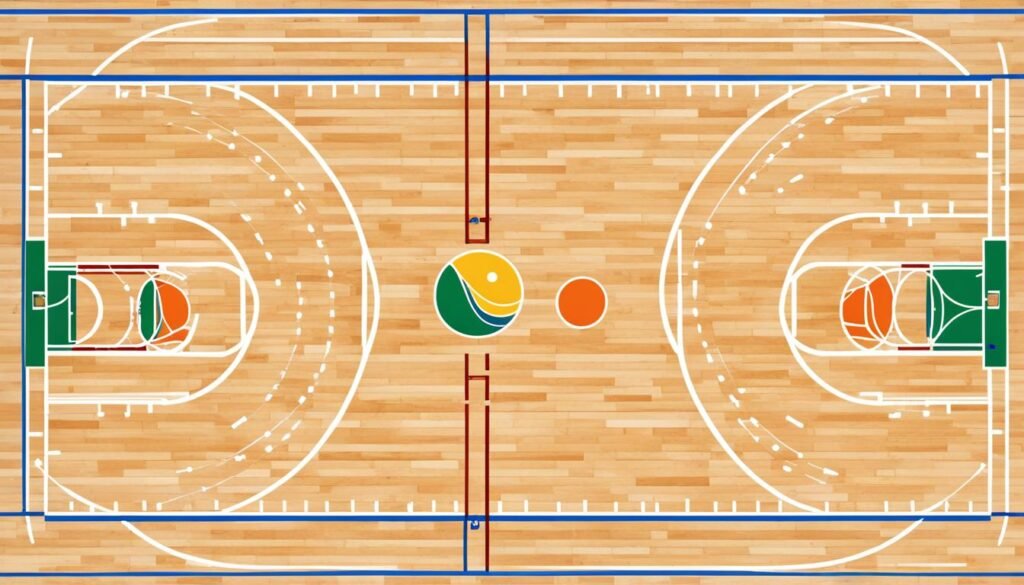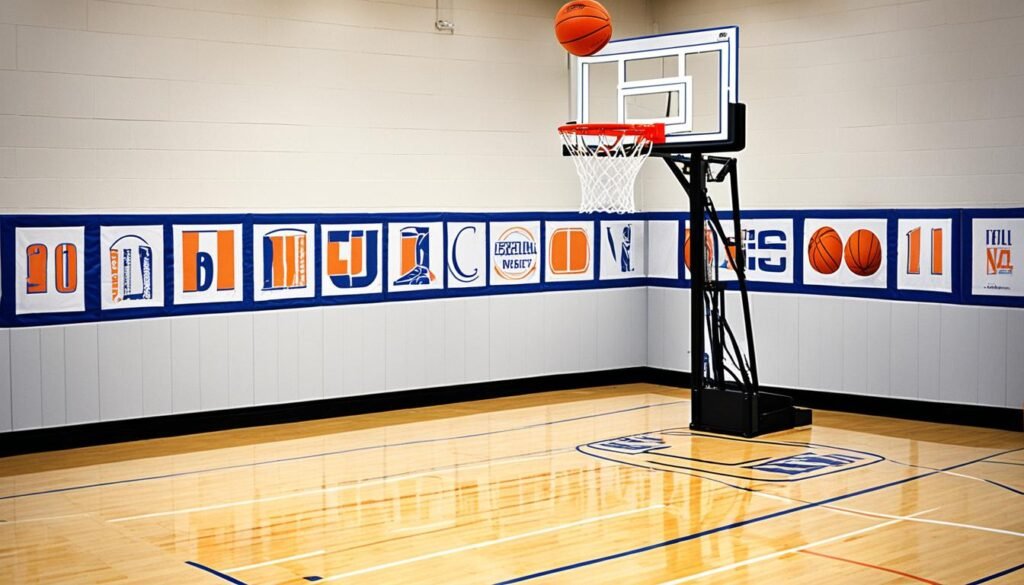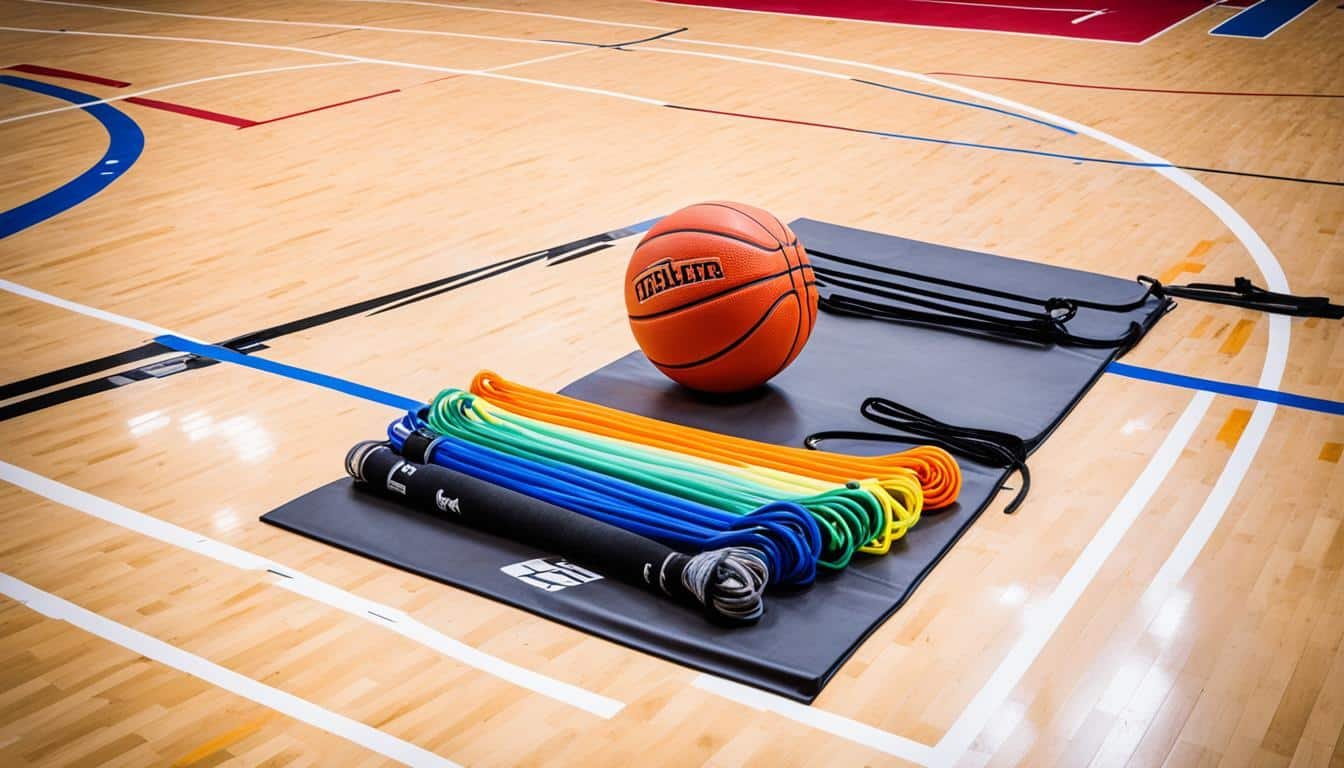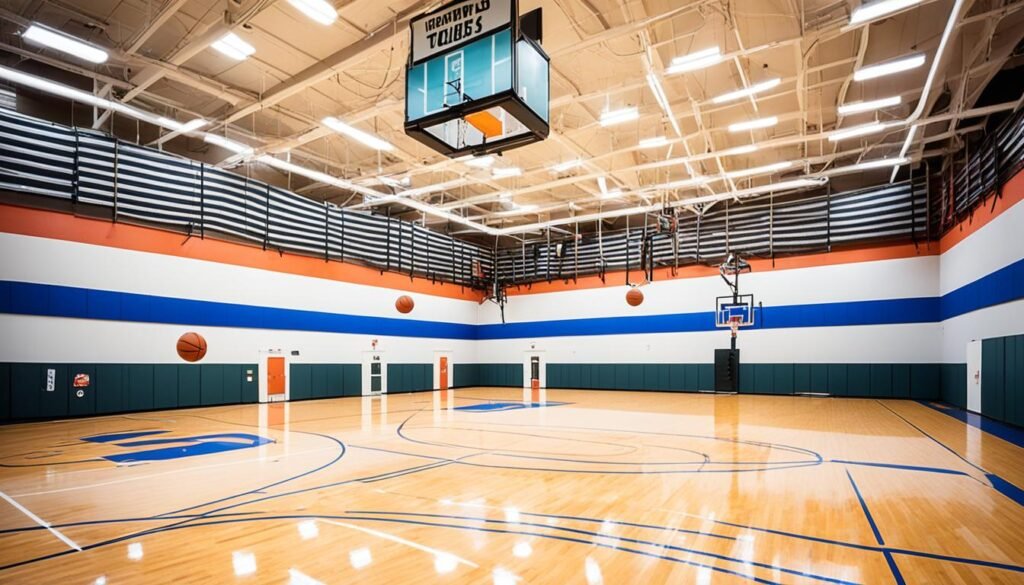Indoor Basketball is a sport that’s fast, fun, and loved all around the world. It was created in the United States back in 1891. Most games are played indoors on a 29 meters by 15 meters court with a wooden floor. The court has a backboard and a basket on each side at a height of about 3 meters. The official ball is made of leather and is around 76 cm around. There are key lines on the court like the midcourt, center circle, three-point line, and free throw line.
Each team has five players that can change during the game. They are made up of two guards, two forwards, and a center. A basketball game has four quarters that are 12 minutes long each. If it’s a tie after the four quarters, the game goes into overtime. In overtime, teams play extra 5 minute periods until there’s a winner.
Players get points by putting the ball through the basket. They get three points if they shoot from behind the three-point line. Shots made inside the three-point line count as two points. When a player is fouled, they take free throws worth one point each.
Key Takeaways: Indoor Basketball
- Basketball is played on a rectangular indoor court measuring 29 meters long and 15 meters wide.
- Each team has five players who can be substituted at any time, with specific positions like guards, forwards, and a center.
- Players can score points by shooting the ball through the basket, with three points for shots behind the three-point line, two points for inside the line, and one point for free throws.
- Professional basketball games are divided into four 12-minute quarters, with overtime periods if necessary.
- The court features important lines and markings, such as the midcourt line, center circle, three-point line, and free throw line.
Introduction to Indoor Basketball
Basketball began in 1891, thanks to James Naismith. He was a PE teacher at a school in Springfield, Massachusetts. Naismith wanted a game that his students could play indoors during winter.
Origins and History of Indoor Basketball
His new game became very popular quickly. Soon, people all over the U.S. and the world were playing basketball. Now, over 300 million people play basketball. It’s one of the top sports.
Popularity of Indoor Basketball Worldwide
Now, basketball is huge. There are leagues, big tournaments, and games in special indoor spots. These places are made just for basketball all over the globe.
Indoor Basketball Court Dimensions and Setup

Indoor basketball has specific dimensions that affect the game and how it feels to play. A standard indoor court is 29 meters (94 feet) long and 15 meters (50 feet) wide. This size offers enough room for players to move and make plays. Plus, the hardwood floor helps players grip and perform at their best.
Standard Court Size and Measurements
The indoor basketball court is carefully planned to make games fair and exciting. It’s 29 meters long (94 feet) and 15 meters wide (50 feet). This size supports a fast, dynamic game while giving players enough space to work their game plans. Such a court is common in pro leagues, colleges, and high-end recreational facilities.
Court Markings and Lines
Various lines on the court tell players where to go and mark the playing area. You’ll see a midcourt line, a center circle, a three-point line, and a free throw line. These lines set the rules and boundaries of the game. They make sure play is fair and everyone knows where they should be.
Basketball Hoop and Backboard Specifications
The hoop and backboard are key parts of any indoor court. The hoop stands 3 meters (10 feet) high. It’s a tough, but reachable spot for shooting. The backboard is 1.8 meters wide and 1.2 meters high. It’s for aiming and rebounding. Indoor games use a ball that’s 76 cm around and weighs 567 to 650 grams.
Rules and Regulations of Indoor Basketball
In indoor basketball, the goal is to score by getting the ball through the opponent’s hoop. Inside the three-point line, a basket counts as two points. If scored outside this line, it’s three points. One point is awarded for a successful free throw after a foul.
Scoring System and Point Values
To score points, players need to make successful shots through the hoop. A shot within the three-point line gets you two points. But if you can score outside this line, you get three points.
There are also free throws. Making a free throw after a foul will earn the shooter one point.
Violations and Fouls
Players must follow the rules to avoid violations. One common fault is Traveling, which is taking too many steps without dribbling. It includes holding the ball too long, double dribbling, and stepping out of bounds.
Fouls happen when a player breaks the rules by pushing, holding, or hitting an opponent. The fouled player gets the chance to shoot free throws.
Game Duration and Time Management
A pro indoor basketball game has four quarters, each 12 minutes long. There’s a 15-minute break between the second and third quarters. Overtime is played if the game is tied after regulation.
Time management is key. Players need to respect the game clock and shot clock. This ensures the game runs smoothly and gives everyone a fair chance to score.
Skills and Techniques in Indoor Basketball
To succeed in indoor basketball, you need key skills and techniques. These include basketball shooting, basketball dribbling, basketball passing, and basketball rebounding. Shooting is about having the right technique to score points. Dribbling helps in moving the ball forward for scoring opportunities. Passing accurately is key for team play and creating chances. Rebounding lets you catch the ball after a missed shot, giving your team another chance to score.
Players also need to work on their basketball defense. This means having good footwork, moving side to side well, and being able to predict the other team’s moves. Agility and coordination are crucial in the fast-paced game of basketball.
Mastering these basics is important for basketball players at any level. They help you play your best and support your team on the court.
Strategies for Indoor Basketball Teams

Indoor basketball teams use many strategies to get ahead. They mix both offense and defense to surprise their rivals. Good teamwork and knowing each player’s job are key.
Offensive Strategies and Plays
Teams move fast to score with transition plays. These involve quick passes and smart moves without dribbling. They also have set plays to get easy shots. These plays often use a pick-and-roll to throw off defenders.
Defensive Strategies and Formations
Teams guard against scoring with different setups, like man-to-man or zones. They aim to stop the other team from shooting and grab the ball back. Sticking to a plan and talking to each other help the defense work well.
Team Dynamics and Player Roles
How well a team plays together is as crucial as their skills. Everyone has a job, from the guards to the centers. By working together and being led effectively, teams can put their tactics into action and win games.
Equipment Needed for Indoor Basketball

The key items for indoor basketball are the basketball and gear for the players. The ball has a specific size and weight. It falls between 567 to 650 grams (20 to 22 ounces) and measures 76 cm (29.5 inches) around. The material is usually leather or a synthetic type. This is to help players hold and control the ball well during the game.
Basketball and Ball Specifications
The basketball used indoors has precise rules on its size and weight. This ensures all games are fair and equal. The ball’s material is also vital. It affects how well players can control and handle it. This, in turn, influences their performance on the field.
Player Gear and Apparel
Players need the right gear to play their best indoors. This means special basketball shoes that offer great support and grip. They also wear jerseys, shorts, and similar clothes. The aim is to be comfortable and dry. Sometimes, they might wear protective gear like elbow pads and mouthguards. This adds an extra layer of safety and helps their game.
Indoor Basketball

Indoor basketball is popular worldwide in leagues and contests. The National Basketball Association (NBA) is a top league, with teams from the USA and Canada. The National Collegiate Athletic Association (NCAA) also has big tournaments for both men’s and women’s basketball, like the NCAA Division I Championships.
Indoor Basketball Leagues and Organizations
High schools often run basketball leagues and games. They offer a path for young athletes to grow and maybe get college scholarships. Besides, many local and amateur leagues welcome players of any age and skill.
Indoor Basketball Tournaments and Competitions
Competitions are key in indoor basketball. They help players show off and play at the top levels. Events like the NBA’s finals and the NCAA’s March Madness are always thrilling for fans.
Training and Conditioning for Indoor Basketball Players
Indoor basketball players need to train hard. This prepares them for successful play. Physical conditioning is key. It focuses on building strength, improving heart health, and agility.
Physical Conditioning and Strength Training
Basketball players do a mix of exercises. This helps them get stronger and faster. They lift weights to build muscle. They also do fast workouts and plyometrics to boost their quickness and endurance. These regular workouts are vital for the fast and intense indoor game.
Skill Development and Practice Drills
Improving skills is equally important in indoor Basketball. Shooting, dribbling, passing, and defense are key. To get better, players have focused practices. They work with coaches to tailor their training. This helps them strengthen their strengths and overcome weaknesses.
Benefits of Playing Indoor Basketball
Playing indoor basketball is great for your physical and mental health. It’s an intense cardio workout that boosts your fitness, strength, and endurance. The game’s quick-paced teamwork helps lower stress, boost your mood, and make you think sharper.
Social and Team-Building Aspects
From a social point of view, indoor basketball is all about teamwork and friendship. As you and your teammates strive for victory, you build strong bonds and improve communication. Taking part in leagues and tournaments helps create a community where you belong. This makes indoor basketball an excellent choice for fun and health at any age.
Also Read: How To Choose The Right Indoor Sports?
Conclusion
Indoor basketball is full of action and fun. It’s been loved by people all over the world since the late 19th century. The game has clear rules and strategies. You need to know about the court dimensions, equipment, scoring, and player roles to enjoy it fully.
Basketball skills and team strategies are very important. Also, basketball training and staying in good shape matter a lot. These things help you do well in the game. Indoor basketball has many benefits. It’s not just a game; it keeps you fit, sharp, and happy, no matter your age or skill.
Indoor basketball has become a favorite worldwide because of its speed and teamwork. It’s a game that keeps getting better. The fun and challenge of indoor basketball will always be there. It encourages new players every day to join and have a great time.
FAQs
What are the basic rules of indoor basketball?
Indoor basketball aims to score points by making shots in the opposition’s hoop. A shot inside the three-point line nets two points. Shoot from beyond the three-point line and you get three points.
Players have to dribble the ball while moving. They can’t hold the ball too long or take more than one step. This rule is to prevent traveling.
If someone fouls you, meaning they push or hit you, you get free throws. One foul shot equals one point.
A professional game includes four quarters of 12 minutes each. There’s a 15-minute break between the second and third quarters. Overtime is played if the score is tied after the regular game, with each overtime period lasting five minutes.
What is the history and popularity of indoor basketball?
Basketball was born in 1891 by James Naismith in Springfield, Massachusetts. He wanted a game for indoors during winter.
The popularity of basketball quickly grew. It spread across the United States and the world. Today, over 300 million play it.
It’s a big deal now, with pro leagues and games in special indoor arenas.
What are the standard dimensions and setup of an indoor basketball court?
An indoor court is 29 meters (94 feet) long by 15 meters (50 feet) wide. The floor is hardwood.
It has markings like the midcourt line, three-point line, and free throw line. The hoop is 3 meters (10 feet) high with a 1.8-meter (6 feet) backboard.
The official ball is 76 cm (29.5 inches) in circumference and weighs 567 to 650 grams.
What are the key rules and regulations of indoor basketball?
To score, make shots: three points from outside the three-point line, two from inside, and one from free throws.
Turnovers happen if you travel or carry the ball. If someone fouls you, you get free shots based on the foul.
Games have four quarters lasting 12 minutes each. Overtime, five-minute periods, are played if scores tie.
What are the essential skills and techniques in indoor basketball?
Skills for indoor basketball include shooting, dribbling, passing, and rebounding.
Good shooting skills and form help in scoring. Dribbling moves the ball up the court. Passing is key for teamwork. Rebounding gives extra chances to score or stops the other team.
Defensively, players must have good footwork and move well to block opponents’ plays.
What are the key strategies for indoor basketball teams?
Teams use many strategies to do well. Offense includes fast breaks, set plays, and pick-and-rolls for scores.
On defense, methods range from guarding specific players to zoning areas. The aim is to stop or slow the other team.
Effective communication and understanding roles are very important. They help the team work together better.
What equipment is needed for indoor basketball?
To play, you just need the basketball and the right gear. The ball, made from leather or synthetic material, should be 76 cm (29.5 inches) with a weight of 567 to 650 grams.
Players use special shoes for basketball, which provide good support and traction. Clothes like jerseys and shorts help with movement.
Some players might also wear protective gear for safety, like mouthguards. Accessories like headbands or wristbands can be used too.
Where is indoor basketball played?
Indoor basketball is in many leagues worldwide. The NBA is the top pro league, featuring teams from the US and Canada.
College leagues, like the NCAA, also hold championships. High schools have teams, offering a path to college on scholarships.
Amateur and community leagues also play, making it accessible to players of different ages and levels.
How do indoor basketball players train and condition?
Players need to train hard to play well. They work on physical fitness with strength and cardio exercises.
They also practice basketball skills a lot, like shooting and passing. Coaching helps them improve their play.
Consistent practice is key to doing better. It improves their thinking during games and enhances their skills.
What are the benefits of playing indoor basketball?
Playing basketball indoors is great for the body and mind. It’s a workout that makes you fit and strong.
It’s also fun and good for mental health, reducing stress and lifting mood. The game teaches teamwork and boosts social life.
Being part of a team or league creates a sense of community. It also offers chances to grow and meet new people.
